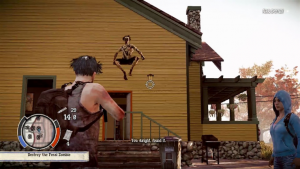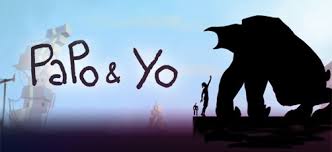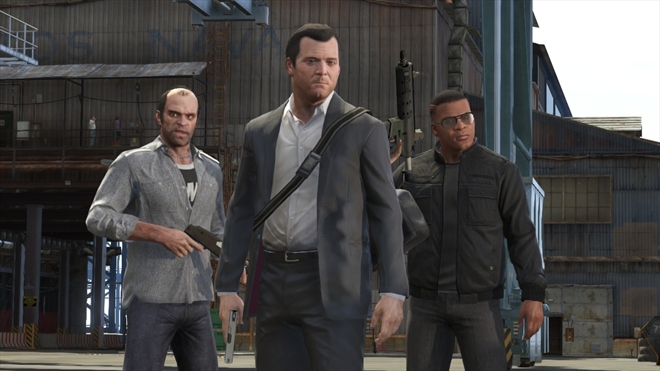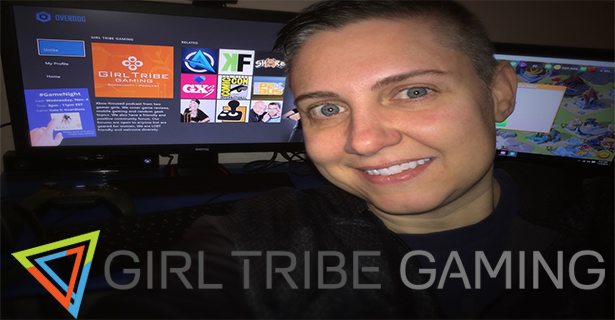Not long ago, I started playing State of Decay again. I know, I know, but at this point, it’s become a comfort object for me, something to help me relax during a busy week. I started a new Breakdown game and fiddled a little with Lifeline again, and looking at those two modes together in a short span of time helped me realize that I’ve rarely played through any mode with a white male anchoring my team, with the exception of ol’ Andy Pimms, who in main story mode. In the main story mode, Andy is described as a homeless man, a toothless alcoholic one of the characters cared for; there’s a whole side mission dedicated to finding Andy and learning his fate, but in Breakdown, magically, he’s returned to you as a hero character, and he’s on the roster of regulars for me. Sometimes I choose him to start, though he’s low on that list (see below), but if he appears in the game, I drop everything to recruit him, because ol’ Andy Pimms is amazing.

My other go-to heroes in Breakdown?
- Gurubani, the Year One Survival Edition character
- Amelia, one of the game’s most reliable fighters
- Lyanna, who starts with a tremendous axe, but who is limited in inventory capacity
- Marcus, whose leadership qualities help with recruitment, and who is the starting character in story mode
- Andy, who’s somehow the sneakiest, luckiest guy in the game
The heroes I’ll always keep around if possible, outside of the above?
- Alicia, the commander from Lifeline
- Sam, whose wits and reflexes make her a very useful fighter and runner
- Becca, the tattoo artist who can boost morale
- Zeika, another strong fighter
- Calliope, the gardener
There’s almost no men on my dream team, and of the two men, only one appears to be white. At least three of the women are nonwhite, as best I can speculate. All these hours (hundreds now; several hundreds) playing this game, and I’ve been surrounding myself with a spectrum of women, something few gaming experiences have ever offered. This is the apocalypse; I choose my teams in Breakdown, choose who survives and moves on, and mostly, I choose women. Oh, sure, I’ll sometimes have random-sweater-guy, or maybe another male hero, but these are my favorites. These are the teams I build for the later levels, when resources grow more scarce and the danger ratchets up, teams of women with multiple skills, teams that are diverse not only in terms of look but also in presentation and attitude, and it’s wonderful. If you’ve gotta be in the apocalypse, might as well make it an inclusive one if you can.
In Lifeline, there’s less choice. You have your team at the military base, and you pick up a few people here and there, but that mode is less about building anything than it is about just getting through the day and working to survive the next. While you can still choose your main characters to play, the leader is set, in terms of story, and here, that’s Major Alicia Hawkes, a hardened soldier. I’ve talked about her before, about how she’s presented, how refreshing it is just to see a woman leading men and getting things done without her gender or sexuality at the forefront, without anything in play but the mission and baggage and the struggle… exactly the way she would be presented if she was a male character, I think. That approach leaves room for delight up front (yes! a female commander!) and then it’s just no longer an issue. She’s just the leader, and you play.
That last bit may make it sound like it doesn’t matter. “But, Alisha, you just said it doesn’t, even! That you just play the game, so why not make her a man?” It’s simple: it matters because we’re so rarely given women in power without other objectifying trappings; it matters because women are rarely just allowed to be people who have things to do. It matters because we so rarely see visible, important female characters who aren’t sidekicks or love interests (or both), and we need to see that, because that’s life, even though a lot of people are convinced it isn’t. That visibility, that care of creation, that helps break down barriers for all of us.
When we spoke with some folks from Undead Labs back in Episode 104 of the podcast, they said this diversity was definitely by design, that they wanted this world to be real, and maybe that’s part of why I keep coming back, so I can exist in this virtual world in which, finally, women are allowed to lead. Where you start the first part of story mode as a Black man who isn’t a caricature, but just a guy with a great voice on vacation. Because so many other games lack that reality. They suffer from the same tropes and repeated issues with representation we see in other media, and the black men die first, and the women are objects to be fought for in love triangles that increase the drama. Here, it’s just people, struggling to go on, and as someone in love with the apocalypse setting, I wish I saw that simple facet more often.
This piece was written as part of Critical Distance’s October Blogs of the Round Table on Leadership.





2 thoughts on “It Always Matters When it Doesn’t: On Diverse Leads in State of Decay”
Wow, this piece makes me happy! After playing through the base game and Lifeline I started noticing this pattern and I found it strange that hardy anyone in the gaming community commented on it. Yeah, SoD does a good job at presenting interesting and complete female characters.
(possibly spoilers ahead for readers who never played SoD)
Concerning female leadership: I would say that Marcus is in fact the only male leader in the series. The Courthouse survivors are led by a female judge (who, like Marcus, is black); the Grange survivors are (apparently) led by Becca; the troops in Trumbull Valley are led by Montressor; then there’s a few random groups without clear leaders and the Wilkersons of course, but they don’t really appear to have a leader either.
In Lifeline, there’s something else you may or may not have noticed. Upon reaching the base you will meet two soldiers who are randomly picked, but they’re always a male and a female. Every time, the female is the sarge and is credited by Hawkes for holding the position. Right after you meet them, you can check your journal and Hawkes will have made a note that says something like “[female sergeant X] managed to hold this position”. I’m quite sure this is deliberate, because I played through Lifeline several times and it happened every time.
What I also think is commendable, is that the devs let female characters be leaders without making them ‘perfect’ in some weird, artificial way. The apocalypse means the destruction of every aspect of society as we know it; leadership isn’t somehow impervious to that.
– Judge Lawton gets credit from that one cop for saving a bunch of survivors by having them hole up in the courthouse; however, she naively believes that the rule of law will be restored soon and insists that survivors lay down their weapons. Judge, please. When things eventually end badly for her group, it’s not explicitly linked to her naive leadership but it surely didn’t help in the long run either.
– Montressor ruthlessly sticks to her mission and even outright refuses to allow Sgt. Tan to help survivors in need at some point. As survivors we can only speculate if her behaviour makes any sense because we don’t know anything about what information, orders and pressure from higher-ups – or lack of these things – she has to deal with.
– If you check Hawkes tab, it says that, after an investigation, she was found not guilty of a friendly fire incident. This event is not specified further, but the tab says that this “bad call” weighs heavily on Hawkes. It doesn’t influence the character in any way, stat- or mechanics-wise, but it gives her a bit more context and an angle for roleplaying if you are so inclined.
I’ve also done a really nice Breakdown run with an all-female team: Montressor, Amelia, Maya, Becca, Construction/Medical Girl and another generic one with a helpful personality and Reflexes. By the way, that is when I noticed that only about one third of all the available survivors are female. Running an all-girl team therefore really narrowed down my recruitment options but I could still cook up this team that covered all the necessary skills. Construction/Medical Girl is awesome because of her home skills and I tried to never let her go outside the walls for that reason. Her sheltered existence always (understandably) started to depress her after a while so I had to take her out to scavenge and fight a bit. I always feared for her life because she was such a big help in later levels when I sometimes had several diseased crew members before even reaching a viable home site. Haha, so many good memories about this game that indeed is a breath of fresh air regarding portrayal of women.
By the way Alisha, you might have heard of it already but if you like SoD I would strongly recommend you check out Dead State. I got it only recently and it’s really good. It has a lot of similarities with SoD, but with less speed and action (combat is turn-based) and a whole lot of interaction with fellow survivors through dialogue. The dialogue is well-written in my opinion and the game does some valuable work in portraying a diverse cast of characters.
Kind regards from a Dutch reader
Thank you so much for the long, thoughtful comment! Yes, I love that the characters are flawed — it adds to the story, which is kind of an amazing feat, since the story doesn’t take up that much space onscreen, really. But there’s a sense of reality around the characters that is refreshing.
I’m not sure I agree on Marcus as the only male leader, though. Thomas is in the brief time we know him, and Erik Tan takes control of the get-out-of-dodge effort. But I do agree in that the game has an enormous amount of female leaders, more than I have seen maybe anywhere else. And as you say, these women are flawed and real; they’re also not objectified or played as love interests. Even Becca escapes that because her story is her story.
Unfortunately, I don’t have Dead State because it’s Windows only! I need to make time to set up my computer so I can dual boot for Windows games, but I just haven’t been able to. There are a few things I really want to play and can’t.